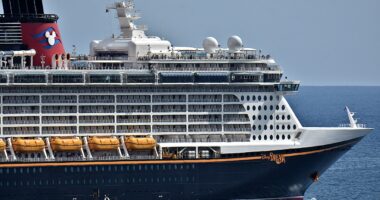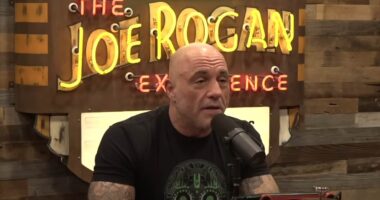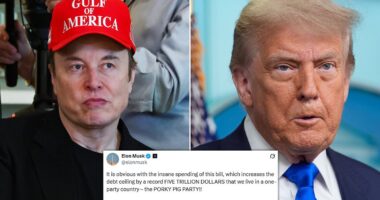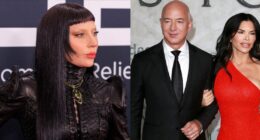The self-styled ‘Painter of Light’ looked like an average American dad.
He carried a few extra pounds and sported a goatee as he spoke with fatherly instruction during art lessons from stages and TV screens.
Thomas Kinkade became a well-known figure in the art world for his unique style of creating nostalgic and sentimental paintings of domestic scenes and vibrant flowers. His artistic approach was unlike anything seen before, with a focus on capturing light in a way that seemed to radiate from his cozy cottage settings, giving his work a magical quality.
Known by his trademarked nickname, Kinkade’s ability to play with light and create an illusion of glowing windows in his artwork set him apart from other artists. This distinct style not only made his pieces visually striking but also emotionally captivating, appealing to a wide audience.
Despite his humble beginnings and challenging upbringing in a less-than-ideal environment, Kinkade remained committed to his belief that art should be inclusive and available to everyone. Through his art, he was able to reach ordinary individuals and touch hearts with his extraordinary talent, leaving a lasting impact on the art world.
With the help of a loyal team and his family, Kinkade launched a groundbreaking commercial brand. His light-filled works could be found during his heyday in an estimated one out of every 20 homes in the US, the company claimed.
His images were emblazoned on throw rugs, collectible plates, ornaments, books, armchairs and other household treasures that flew off the shelves. A Kinkade-themed neighborhood was constructed in Vallejo, California, to fully immerse superfans who rode on a branded tour bus.
As suburban Americans clamored for his images of light, however, the painter himself was struggling with personal darkness. He was channeling it into tortured art that he secretly hid from the world and his family in a tiny, locked vault.

California artist Thomas Kinkade exploded in popularity across the US during the 1990s for his bucolic and comforting scenes of cottage and other blissful images full of color and light

Documentary Art for Everybody, which will be theatrically released on March 28, explores the demons that tortured Kinkade all along. He died in 2012 from an accidental overdose of alcohol and Valium. Kinkade is pictured in a youthful self-portrait

Kinkade’s signature style marked his ability to depict light, usually emanating from the windows of cozy cottages
And while the art world turned up its nose at Kinkade’s mass-produced ‘twee’ paintings, he was wrestling with the demons similar to those that haunted the celebrated artists he admired like Van Gogh.
Like so many other artists before him, Kinkade’s struggle descended into the loss of his family, his company, his unbridled success, and, tragically, his life.
He died at age 54 in 2012 after an accidental overdose of alcohol and Valium.
Now, a documentary film is bringing that tragic story to the masses. The film, titled Art for Everybody, premieres in theaters on Mar. 28 and will be shown in select cinemas across the country. It will let audiences in on both the light and the dark, providing a glimpse into Kinkade’s vault of alternate works.
‘He had fans who had one completely two-dimensional view of who he was, and he had critics who had a totally different two-dimensional view of who he was,’ director Miranda Yousef tells the Daily Mail.
‘And the existence of this whole other body of work really allowed for me to pursue … an understanding of a three-dimensional person.’
Kinkade wanted to be an artist from an early age. He grew up in Placerville, California, where his single mother raised him with his siblings.
The artist felt somewhat inferior because of his fractured family, his siblings say in the film. So it wasn’t such a leap when Kinkade eventually began churning out scenes of domestic tranquility and comfort.
‘As kids, we always came home to a dark, old house, and that’s why all the lights are on in the cottages that he makes,’ Kinkade’s brother says in the film. ‘And what that represents is the person waiting, the family there, the hearth that’s lit and warm.
‘All these things that make life worth living are encapsulated in that cottage.’
Kinkade studied art at University of California, Berkeley, and briefly worked in animation before setting out on his own. At his 1982 wedding to wife Nanette, whom he’d met as an adolescent in Placerville, Kinkade was already joking about finding ‘fame and fortune.’
When he and Nanette made $40,000 selling his prints outside a Placerville store, the dream no longer seemed like an unattainable fantasy.
‘From day one, he wanted to make his art more accessible to a larger population; he just had a heart for people who loved art but couldn’t afford original art from a standard gallery,’ Nanette says in the film. ‘So he started to publish limited edition prints.’
An audio clip played during the film reveals Kinkade’s outlook on his work and career: ‘A novelist wouldn’t want to write a novel only to have one copy made, but rather wants millions to enjoy it. That is my goal as an artist, as well.’
A chance meeting at a wedding with future business partner Ken Raasch helped make that happen.

Kinkade forged a career focused on light, faith, and family, naming four of his popular prints for each of the four daughters he raised with his wife, Nanette

Kinkade’s family discovered secret dark and tormented artworks after his death that he’d stashed in a vault
‘I really saw an opportunity,’ Raasch says in the film. ‘I saw that there wasn’t a brand in the area of art. We wanted one artist to be collected by 90% of people.
‘So how do you get there? By saying the true subject, the true theme of Tom’s work, is light … that’s really what caused us to come up with the “Painter of Light” name.’
The art, the light, and Kinkade himself clearly resonated with the American public, who gobbled up his works and wholesome image. His wife and four daughters were frequently by his side during appearances, and Kinkade even named a painting for each of his four daughters. Chandler, Merritt and Everett all got their own painted cottages, while Winsor got a manor house ‘because he wanted to include a W in the painting,’ she says in the film.
‘I lead a very simple life,’ Kinkade said in one interview. ‘It is a life focused on family, focused on home, focused on my children, focused on my faith in God.’
It was also focused on steamrolling success and sales. Kinkade and his team expanded from prints to essentially everything else, from collectibles to real-life homes.
They opened signature galleries in malls and towns across the country. Kinkade sold his wares on shopping networks. He gave art lessons on TV and in person, and fans lined up in droves for autographs, some even handing him prayers they’d brought for him in envelopes.
‘The company did $2 million in ’92, and by 2000 it was breaking $100 million,’ former president and CEO Dan Byrne says in the film. ‘For the time period that was in, and for what was being sold, that was unheard of in America.’
As the Kinkade behemoth barreled full-speed ahead, however, the painter’s demons were catching up with him.
At 16, he’d recorded himself saying: ‘I want to be an artist, I have that dream. However, I’ve been also realizing … I don’t want to end up like Van Gogh. And yet something within me says I do want to end up like Van Gogh for the sake of achieving greatness.’

At 16, Kinkade recorded himself saying: ‘I want to be an artist; I have that dream. However, I’ve been also realizing … I don’t want to end up like Van Gogh. And yet something within me says I do want to end up like Van Gogh for the sake of achieving greatness’

Before building a career on wholesome, bucolic paintings, Kinkade mused: ‘I want to know the truth and convey it. And above all, I want to avoid painting silly and sweet pictures, charming pictures, happy pictures. I want to paint the truth. And the truth of this world is not happiness. The truth of this world is pain – and that’s the only truth’
Decades later, standing before a signature gallery conference, he said: ‘I’m put in a different position than any artist in the history of the world – the master, working through me.
‘God has built something here that’s been beyond any of us, so I’m not going to fall victim to the same kind of crises and erosion of the lifestyle that you see in so many people who get put in the public eye.
‘That won’t happen to me, by God’s grace.’
Kinkade had never been a drinker, but he took up the habit with gusto – something his wife originally welcomed because it seemed to calm this man whose mind and behavior could be frequently manic.
But everything magnified as Kinkade’s company faltered. He separated from his business partner, Raasch, and brought in a new regime. Strategies changed, along with the market. Share prices tanked.
He and the company were hit with lawsuits from art dealers and gallery owners who accused them of ‘cranking out a lot of merchandise that they couldn’t move and forcing them to buy in wholesale — and at the same time withholding pertinent financial information that would have kept them from investing in the business,’ Kim Christensen, who wrote about the actions for the Los Angeles Times, says in the film.
‘And the other big chunk of the litigation alleged that Kinkade had traded on his Christian faith to induce these people into going into business with him.’
By 2010, Kinkade’s life was spinning out of control. Nanette filed for legal separation, his company filed for bankruptcy, and he was arrested for driving under the influence.
He had fast become the subject of gossip and unsavory headlines for his spiraling behavior. Public incidents included heckling Siegfried and Roy in Las Vegas, urinating on a Disneyland character, and groping a woman while publicly admiring her breasts.

‘From day one, he wanted to make his art more accessible to a larger population. He just had a heart for people who loved art but couldn’t afford original art from a standard gallery,’ Kinkade’s wife, Nanette, says in the film. ‘So he started to publish limited edition prints’

Director Yousef tells the Daily Mail that she feels her Kinkade documentary ‘is really about how denying yourself full self-expression will destroy you’
Even his appearance completely changed. He grew his hair long and began wearing skull jewelry. At one point, his sister found him on a mattress in his studio, surrounded by bottles.
When the painter was found dead in April 2012, the coroner ruled it an accidental overdose from alcohol and Valium.
It was only after this devastating loss that Kinkade’s family found his shocking, hidden collection of art. It was full of the types of works critics had derided him for never painting.
‘I think that the broad phrase you can use kind of as an umbrella for these works is psychological torment,’ Yousef, who had the opportunity to visit the vault as part of filming Art for Everybody, told the Daily Mail.
‘It was kind of sad,’ she continued. ‘I mean, it was exciting – it was sort of thrilling to … be one of the first people in the world to see these works.
‘But it also just was really tragic to me. It was really sad. And so, for me, the movie is really about how denying yourself full self-expression will destroy you.’
Her statement is all the more revelatory when paired with Kinkade’s own musings.
‘I want to know the truth and convey it,’ Kinkade recorded himself saying. ‘And above all, I want to avoid painting silly and sweet pictures, charming pictures, happy pictures.
‘I want to paint the truth,’ he can be heard saying in the film. ‘And the truth of this world is not happiness. The truth of this world is pain – and that’s the only truth.’

















